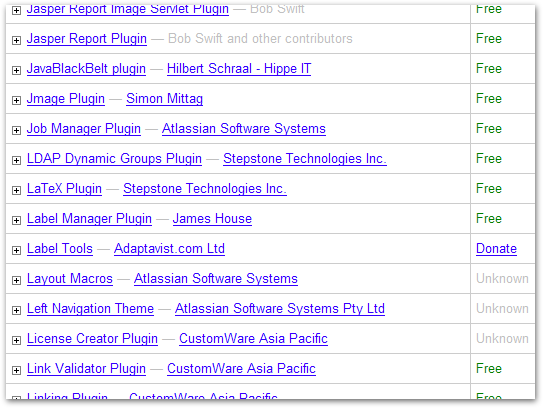[All Adaptavist Apps]
Plugin and Play
Note: If you're a theme developer or designer, you probably want to read Layout Design instead
Whether you want to theme your custom actions, make it easy for designers to add CSS to your macros or even want to create mini-applications, this theme provides an arsenal of functionality aimed at reducing your workload...
Seamless Integration
The theme is brimming with customisation options allowing you to seamlessly integrate your own features in to the wiki's navigation.
You can also seamlessly integrate your actions and macros in to the wiki by applying the theme to them.
CSS Injection
Leave the aesthetics to designers - add a few simple classes to your HTML markup and let them do the rest with CSS. The theme makes it easy for designers to inject CSS, leaving you free to get on with coding.
Bundled Libraries
Theme Builder is bundled with some of the most widely used libraries currently available.
jQuery
jQuery is a fast, concise, JavaScript Library that simplifies how you traverse HTML documents, handle events, perform animations, and add Ajax interactions to your web pages. jQuery is designed to change the way that you write JavaScript.
Prototype
Prototype is a JavaScript Framework that aims to ease development of dynamic web applications.
Featuring a unique, easy-to-use toolkit for class-driven development and the nicest Ajax library around, Prototype is quickly becoming the codebase of choice for web application developers everywhere.
Script.aculo.us
This library provides you with easy-to-use, cross-browser user interface JavaScript libraries to make your web sites and web applications fly.
What's inside? animation framework, drag and drop, Ajax controls, DOM utilities, and unit testing.
Browser Detection
Your client-side scripts can use the theme's inbuilt JavaScript browser classification API to determine all manner of information about the end-user environment.
Import your own
The JS Tab in the Layout Manager allows you to easily include your own JavaScripts and libraries. Rather than forcing the entire wiki to include libraries using Confluence's "Custom HTML" feature, you can now load the libraries just where they're needed.
HTML Injection
Theme Builder fully supports the Custom HTML feature found within Confluence - administrators can inject HTML in to the <head>, just below the <body> and just above the </body> tags.
User Macros
You can also use User Macros (another standard admin-only Confluence feature) to inject HTML in to theme panels and page content. With the added benefit of Velocity templating, you can pass in parameters, do simple iterations and conditional logic, etc.
<html> tag
Theme Builder allows you to add additional markup inside the opening <html> tag, useful for adding VML namespaces when using things like the Google Maps API:
<html xmlns="http://www.w3.org/1999/xhtml" xmlns:v="urn:schemas-microsoft-com:vml">
Macros Galore
This theme is chock full of all kinds of useful macros to help with a wide variety of tasks.
For example, you can show or hide your own macros in the theme or in pages based on page title, labels, metadata, context and mode to name but a few. You can run your macros in the context of other pages and even other spaces if so desired (with full adherence to user privileges of course) by wrapping them in macros included in the theme plugin.
Menu Driven
Easily add menus to your own macros and actions using the menu system included
You can even add menus to normal wiki content - perfect for creating small software simulations!
Third Party Plugins
There's a vast array of open source plugins available for Confluence and you can easily wire them in to the UI.
You can generate navigation and panel content using SQL, XSLT, scripting languages, Java plugins, user macros, portlets to name but a few.
{diagram}
(Basket
(Item
(Bundle
(Product)
(Product)
)
(Bundle
(Product)
)
)
(Item
(Bundle
(Product)
(Product)
)
)
(Discount)
(Discount)
)
{diagram}
Scaffold and Metadata Compatible
The latest version of the open source Scaffolding Plugin (advanced Confluence templating) is fully compatible with Theme Builder.
We've also integrated the theme with the open source Metadata Plugin (all versions!) so you can show and hide content based on metadata on the current page and even parent pages.
Web UI link integration
Theme Builder replaces the vast majority of Confluence navigation links and allows theme designers and navigation architects to completely customise the navigation.
A slight downside to this is that your Web UI plugin components won't appear by default. But fear not - using the menulink macro you can easily show your Web UI links absolutely anywhere - in menus, as text links, even on specific pages!
If you've developed a publicly available plugin, even a commercial one, let us know what your Web UI links are and we'll add named aliases for them in to the next release of the theme - free of charge!
Mashups
By now you must have realised that the mix of Confluence and Theme Builder is a great platform for "mashups". When you throw Scriptix and the huge number of other open source plugins in to the mix, not to mention any custom plugins you could write, you can do pretty much anything.
By using the theme for your mashups or other development efforts, you are instantly integrated with all the other disciplines involved with your wiki including designers, content authors, administrators, navigation architects and more...
Battle-tested Reliability
Theme Builder has been around since Confluence 1.4 and is in use by 1500+ organisations in 50+ countries. It's been tested on a huge range of client and server platforms. It's even being used on the worlds largest privately owned medical ship!
With customers delivering wiki content to rural India and remote regions in Africa we've had to focus really hard on performance. We're constantly tuning, bug-fixing and updating the theme so you're never left behind.
